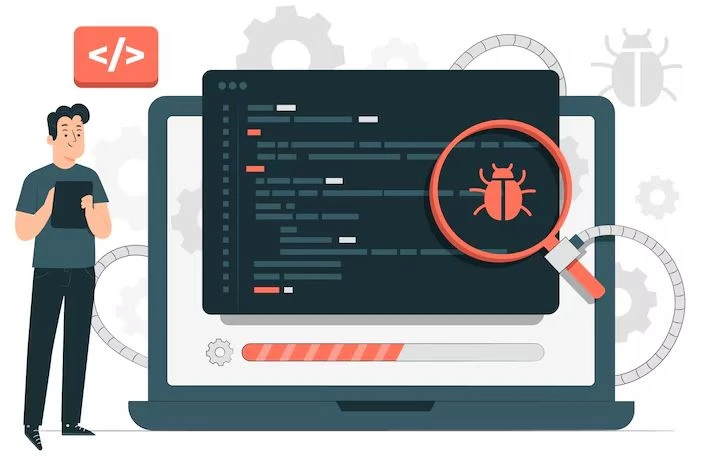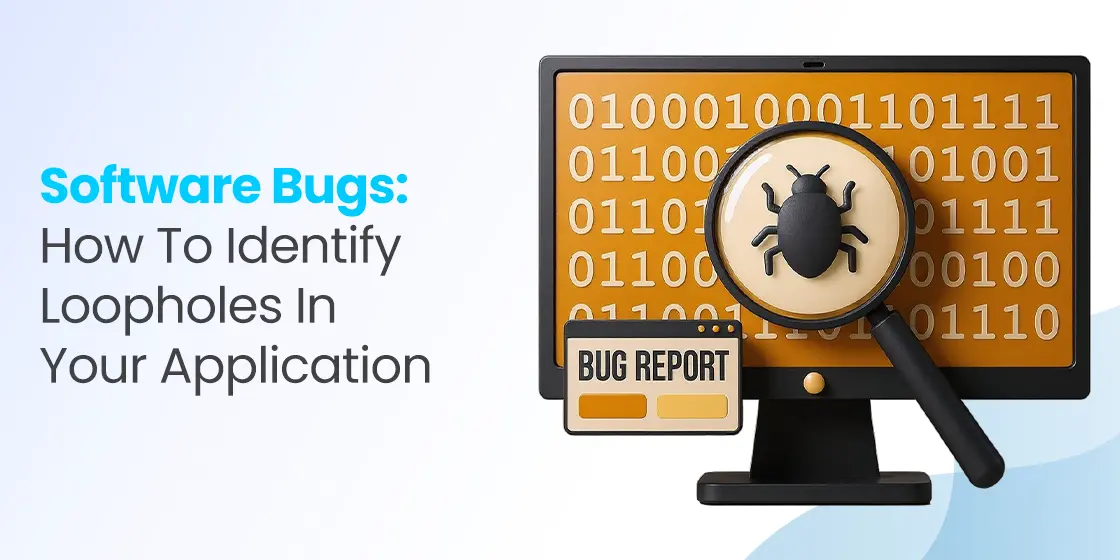Table of Content
Know How to Identify and Resolve Software Bugs Quickly
Software is the backbone of modern society. Whether you’re checking your emails, or playing a video game, software is present at every touchpoint. Its complexity allows us to do incredible things efficiently, quickly, and conveniently. However, as with any complex system, software is not perfect. Even the most well-developed and thoroughly tested programs can contain small flaws — these flaws are what we call software bugs.
Software bugs might seem like a minor concern at first, especially when they don’t immediately cause major malfunctions. Yet, they often hide significant consequences. A small glitch in a program might affect performance, cause crashes, or even open the door to security vulnerabilities that can be exploited by malicious actors. This is why identifying and fixing bugs is a critical part of the overall software development services.
Despite the ongoing improvements in coding practices and automated testing tools, software bugs continue to be one of the most enduring challenges in computer science. They impact user experience, company reputations, and financial outcomes. That’s why understanding bugs and how to manage them is an invaluable skill for developers, testers, and business leaders alike.
What are Software Bugs?

A software bug is an error, flaw, or fault in a computer program that causes it to produce unintended results or behave in unpredictable ways. Bugs can arise for many reasons, including mistakes in source code, incorrect assumptions about inputs, overlooked edge cases, or even incompatible interactions between different components. Sometimes, a bug might cause a complete application crash. Other times, it might simply slow down the program or cause it to give incorrect outputs.
Bugs exist in virtually every kind of software from desktop and mobile apps to operating systems and firmware. Even large companies like Microsoft, Apple, and Google continually discover and fix bugs in their products. It’s simply an unavoidable part of the creative process, especially as modern software grows increasingly complex with new features and dependencies.
The impact of a bug can vary greatly depending on its severity. Some bugs are trivial and only cause minor inconveniences, while others can lead to data loss, security breaches, or serious system failures. Understanding this spectrum of severity is important in order to classify bugs properly and decide which ones need immediate attention and which can wait for future updates.
Fuel innovation by leveraging bespoke software solutions. Get in touch with our team of experts to build cutting-edge software products.
Get a QuoteImportance of Timely Bug Identification
Identifying bugs as early as possible is essential for a number of reasons. First and foremost, early bug detection reduces the cost of fixing them. Bugs detected during the design or coding phase can often be resolved in a matter of minutes or hours. However, if they’re left unchecked until the later stages — especially after deployment — they may require extensive refactoring, system downtime, and increased developer effort to isolate and correct.
More importantly, bugs can pose serious risks if left unresolved. A bug that’s overlooked in a commercial application could expose millions of users’ data. Another might cause an important transaction to fail or lead to corrupted data in a critical database. Public trust in a product can also erode rapidly when a company releases bug-ridden software. Customers lose faith, and competitive advantage disappears. Fixing the problem after public release usually comes at the cost of reputation and revenue.
Moreover, timely identification of bugs keeps a software team’s morale and productivity high. Developers who must frequently return to old code to resolve overlooked bugs can lose momentum and focus. Prioritizing early detection helps keep schedules on track and allows teams to spend their time innovating rather than firefighting.
Tips to Identify Software Bugs

Detecting bugs is both an art and a science. Some bugs hide in plain sight, while others may require targeted stress testing or careful code review to unearth. Following a few proven strategies can make the process more efficient and systematic.
Conduct Thorough Code Reviews
Peer reviews remain one of the most effective techniques for identifying bugs. By having a second set of eyes look at the code before it’s merged into the main branch, you can catch errors that might slip past an individual developer. Structured reviews also encourage teams to follow functional requirements and coding standards that recommended in the market.
Implement Automated Testing
Unit tests, integration tests, and end-to-end tests help catch regressions early and ensure that new features don’t introduce unforeseen bugs. Continuous integration (CI) tools can run these tests every time new code is committed to a repository, allowing teams to identify issues quickly.
Unit Testing
Unit tests focus on small, isolated pieces of code — usually a single function or class — to verify that they produce expected results. This level of QA testing provides immediate feedback to developers and can quickly catch logical errors.
Integration Testing
Integration tests check how different components work together. This is crucial because bugs often arise at the boundaries between modules. For example, the data might be correctly calculated by one component but incorrectly parsed by another.
End-to-End Testing
End-to-end tests simulate real-world user interactions with the software. These tests can catch subtle bugs that only manifest when the entire system is running. Automated browser tests, for example, can detect when a user interface element behaves incorrectly after a deployment.
Implement Static Analysis
Tools like linters and static analyzers can help detect potential errors in code before they even run. Static analysis tools examine source code for common problems like syntax errors, uninitialized variables, or security vulnerabilities. Since these tools don’t require the program to execute, they can catch bugs very quickly and often run in a matter of seconds.
Get cutting-edge ERP software solutions built according to your business demands. Hire our dedicated teams to build advanced custom products.
Get a QuoteMonitor Application Logs
Sometimes bugs only surface in production under particular conditions. Application logs can give invaluable insight into those hidden errors. By analyzing log output — especially error messages, stack traces, and warnings — developers can often trace the issue back to its source and reproduce it in a test environment.
Logging Best Practices
When setting up logs, it’s important to capture enough context around the event without leaking sensitive data. Developers should use a structured logging format (e.g. JSON) and ensure that the logs can be searched and filtered easily.
Encourage Beta Testing
Beta testing allows real-world users to put your software through its paces before a final public release. This is especially useful for discovering bugs in unfamiliar environments or hardware setups that you may not have accounted for in development. Consider distributing beta builds to a controlled group and setting up a feedback loop for quick issue reporting.
Perform Stress and Load Testing
Some bugs only appear when the system is under pressure. Load tests help you evaluate the software’s behavior under extreme usage conditions. This might mean sending a high volume of concurrent requests to a web server or pushing a database query engine to its limits. Stress testing often reveals race conditions, memory leaks, or deadlocks that wouldn’t show up under light use.
Frequently Asked Questions
| What is a software bug? A software bug is an error or flaw in a program that causes it to behave incorrectly or unexpectedly. Bugs can lead to crashes, incorrect outputs, or security vulnerabilities. |
| Why software testing is crucially important? Software testing is crucial because it helps identify bugs and errors before the product reaches users. It also improves performance and enhances user trust and satisfaction. |
| What is cyber security? Cyber security is the practice of protecting computer systems, networks, and data from unauthorized access. It ensures the confidentiality, integrity, and availability of information in the digital world. |
Final Words
Software bugs are an inescapable part of the development process — they can appear in even the most rigorously tested code. What matters most is recognizing their potential impact and putting in place effective strategies to catch them early. By understanding what software bugs are, and using proven bug-finding techniques like code reviews, automated tests, and regression testing, teams can minimize their negative effects.
The quest to eliminate all bugs might never fully end, but with a proactive approach, it is possible to reduce their frequency and severity. Doing so not only improves software quality but also empowers teams to innovate with greater confidence. By continually refining your bug-detection practices and making them part of your everyday workflow, you will go a long way toward building software that is robust, reliable, and resilient.
Empower your digital initiatives with BariTechSol, a premier custom software development company. Our skilled team tailors cutting-edge solutions to your unique needs. Elevate your tech experience and stay ahead in the digital realm. Partner with BaritechSol and code the success of your next big idea.


